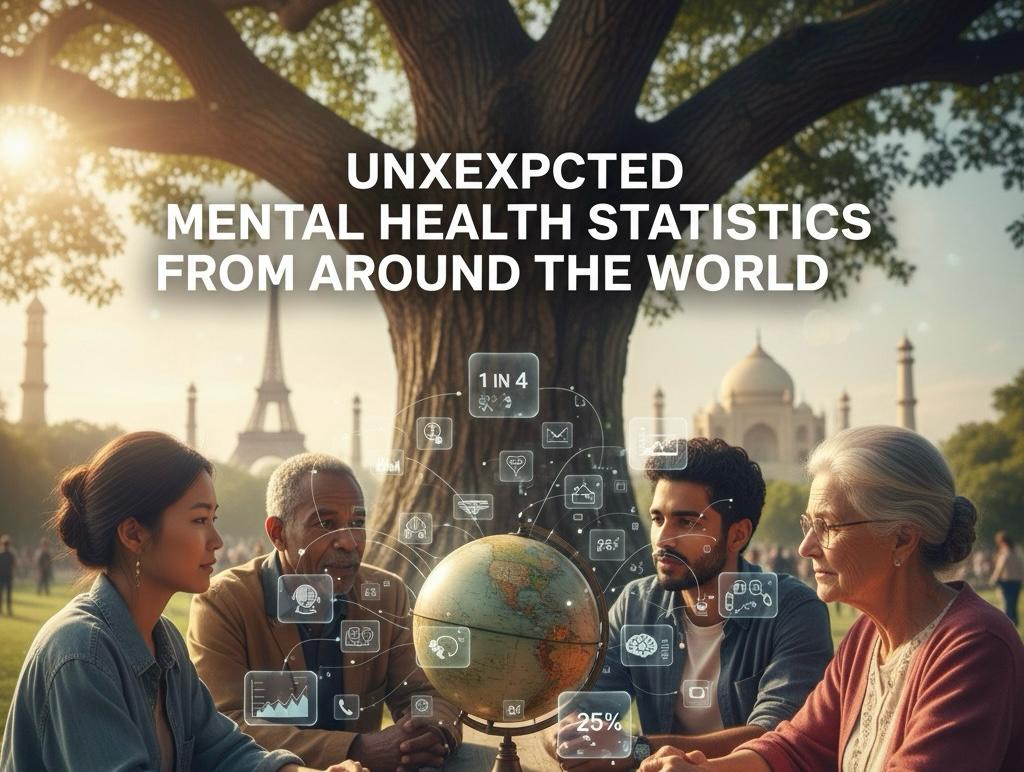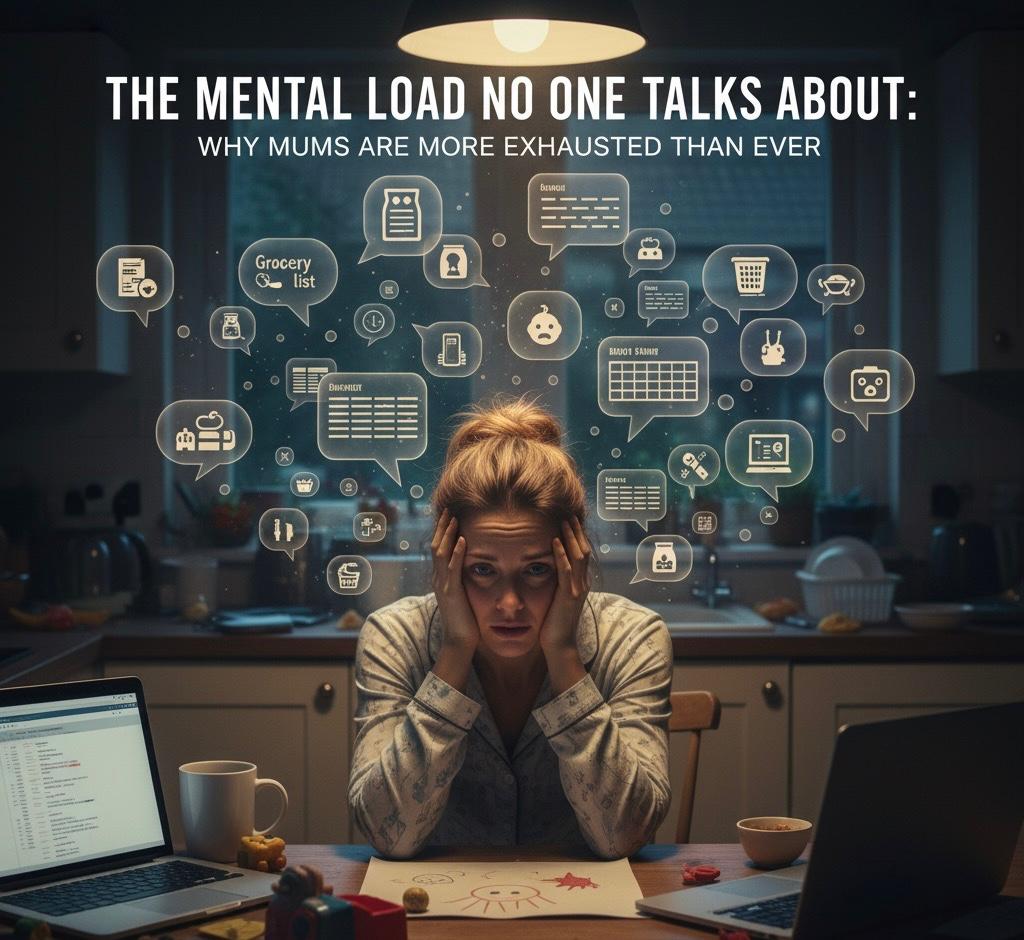Introduction
Global conversations about mental health often focus on familiar headlines: rising anxiety, overworked systems, and the importance of therapy. Yet the data contain counter‑intuitive stories that challenge assumptions: some high‑income countries report higher antidepressant use but similar distress, suicide can be highest in older men rather than teenagers, and the treatment gap remains massive even where services exist. This article curates unexpected mental health statistics from around the world, explains why they matter, and suggests policy and practice implications.
1) Prevalence surprises
- One in eight people worldwide were living with a mental disorder in 2019, with anxiety and depression the largest share (IHME/GBD, 2022). Despite media focus on rich nations, the absolute majority of people with mental disorders live in low‑ and middle‑income countries (LMICs) due to population size (Patel et al., 2018).
- Post‑pandemic pattern: Global prevalence of depression and anxiety rose in 2020, especially among women and younger people, but levels did not increase uniformly; countries with stronger social protection and fewer mobility restrictions showed smaller shifts (Santomauro et al., 2021).
- Comorbidity is the rule: Over 50% of people with depression meet criteria for at least one additional disorder (e.g., anxiety, substance use), complicating care pathways (Kessler et al., 2015).
Why this is unexpected: Narratives imply a simple, rising tide everywhere. Instead, context, policy, and protectionchange trajectories.
2) The treatment gap is larger than most imagine
- In LMICs, over 75% of people with depression receive no treatment at all (WHO, 2022a).
- Even in high‑income countries, only about half of adults with mental disorders access care in a given year, and fewer receive evidence‑based treatment (Thornicroft et al., 2017).
- Child and adolescent gap: In many countries, fewer than 1 in 5 adolescents with a diagnosable condition receive specialist care (WHO/UNICEF, 2021).
Why this is unexpected: Expanding awareness does not equal access; workforce shortages, cost, and stigma remain major barriers.
3) Suicide patterns that challenge assumptions
- Age: In most high‑income countries, men aged 70+ have the highest suicide rates of any demographic group (WHO, 2023).
- Geography: More than three‑quarters of global suicides occur in LMICs (WHO, 2023), but some high‑incomecountries—particularly those with access to high‑lethality means—show elevated rates among men.
- Trends: Global suicide mortality declined ~36% from 2000 to 2019, yet some regions saw plateaus or reversals after 2010 (Naghavi et al., 2019; WHO, 2023).
Why this is unexpected: Public discourse often centres on youth suicide; prevention must also prioritize older men, lethal‑means safety, and alcohol policy.
4) Maternal and perinatal mental health: a hidden global burden
- Perinatal common mental disorders (depression/anxiety during pregnancy or first postnatal year) affect about 1 in 4 women in LMICs and 1 in 10 in high‑income countries (Fisher et al., 2012; Woody et al., 2017).
- Untreated perinatal depression is linked to preterm birth, low birth weight, and impaired child socioemotional development (Stein et al., 2014).
Unexpected angle: Despite cost‑effective interventions, perinatal mental health receives a fraction of maternal health funding, even though benefits extend across generations.
5) Young people: not just more anxious—more isolated
- Loneliness is most prevalent among young adults, not the elderly, in many countries (Luhmann & Hawkley, 2016). Loneliness carries risk comparable to well‑known health factors, predicting depression and early mortality (Holt‑Lunstad et al., 2015).
- School‑based surveys indicate that self‑harm affects 10–20% of adolescents at least once, with wide cross‑national variation (Muehlenkamp et al., 2012).
Unexpected angle: Interventions often target seniors for loneliness, but university and late‑teen cohorts may need the most connection‑focused supports.
6) Economic costs: small budgets, huge losses
- Governments spend a median of 2% of health budgets on mental health; in low‑income countries it is often <1% (WHO, 2022b).
- The global economic burden of common mental disorders is estimated in the trillions (USD) due to lost productivity; every US$1 invested in scaled CBT/antidepressants yields US$4 in health and productivity gains (Chisholm et al., 2016).
Unexpected angle: Mental health financing is among the lowest‑return gaps in health policy—high ROI, yet persistently underfunded.
7) Substance use links that fly under the radar
- Alcohol is implicated in roughly one in five suicides in some regions and contributes to over 3 million deathsannually (WHO, 2018; Cherpitel et al., 2016).
- Co‑occurrence: About one‑third of people with major depression have a lifetime alcohol or drug use disorder(Conway et al., 2006). Integrated care outperforms siloed treatment.
Unexpected angle: Policies that reduce alcohol availability and pricing can lower suicide and violence alongside liver disease.
8) Air pollution, climate, and mental health
- Exposure to fine particulate matter (PM2.5) is associated with higher risk of depression and anxiety, with meta‑analytic evidence linking long‑term exposure to increased depressive symptoms (Braithwaite et al., 2019; Fan et al., 2020).
- Extreme heat correlates with increased suicide and psychiatric ER visits (Burke et al., 2018).
Unexpected angle: Clean air and climate adaptation are mental health policies as much as environmental ones.
9) Workforce realities
- The global median is 13 mental health workers per 100,000 population, but low‑income countries average <2 per 100,000 (WHO, 2022b).
- More than 60% of mental health beds worldwide are still in psychiatric hospitals, though community‑based care shows better outcomes and rights protections (WHO, 2021).
Unexpected angle: Reform isn’t just about more clinicians—it’s about where and how care is delivered.
10) Digital care: high reach, modest effects—unless human‑supported
- Self‑guided digital CBT produces small-to-moderate improvements in anxiety/depression; adding minimal human support substantially increases adherence and outcomes (Karyotaki et al., 2017).
- Despite hype, drop‑out rates for unguided apps remain high; the best results come from blended models (Firth et al., 2017).
Unexpected angle: Technology extends reach, but human connection remains central to durable benefit.
Policy and practice takeaways
- Target older men and alcohol policy within suicide prevention.
- Scale perinatal mental health as a cross‑generational investment.
- Close the treatment gap with task‑sharing (training non‑specialists) and community‑based services.
- Fund mental health at >5% of health budgets, prioritising evidence‑based primary care integration.
- Treat air quality and heat mitigation as mental health interventions.
- Use blended digital‑human care to expand access without sacrificing outcomes.
FAQs
Which country has the highest rates of mental illness?
Comparisons are tricky due to measurement differences. The Global Burden of Disease estimates show substantial burden across regions; population size means most people living with mental disorders reside in LMICs (IHME/GBD, 2022).
Is youth suicide the main global problem?
Youth suicide is a major concern, but in many high‑income countries older men have the highest rates (WHO, 2023), requiring age‑specific strategies.
Do mental health apps work?
Many show small‑to‑moderate effects, especially when paired with human support (Karyotaki et al., 2017; Firth et al., 2017).
References
- Braithwaite, I., Zhang, S., Kirkbride, J.B., Osborn, D.P.J. & Hayes, J.F. (2019) ‘Air pollution (PM2.5) and depression: A systematic review and meta‑analysis’, Environmental Health Perspectives, 127(12), 126002.
- Burke, M., González, F., Baylis, P. et al. (2018) ‘Higher temperatures increase suicide rates in the United States and Mexico’, Nature Climate Change, 8(8), pp. 723–729.
- Cherpitel, C.J., Borges, G., Wilcox, H.C. (2016) ‘Acute alcohol use and suicidal behavior: A review of the literature’, Alcoholism: Clinical and Experimental Research, 40(10), pp. 1927–1941.
- Chisholm, D., Sweeny, K., Sheehan, P. et al. (2016) ‘Scaling‑up treatment of depression and anxiety: A global return on investment analysis’, The Lancet Psychiatry, 3(5), pp. 415–424.
- Conway, K.P., Compton, W., Stinson, F.S. & Grant, B.F. (2006) ‘Lifetime comorbidity of DSM‑IV mood and anxiety disorders and specific drug use disorders’, J Clin Psychiatry, 67(2), pp. 247–257.
- Fan, S.J., Heinrich, J., Bloom, M.S. et al. (2020) ‘Ambient air pollution and depression: A systematic review with meta‑analysis’, Science of the Total Environment, 701, 134721.
- Firth, J., Torous, J., Nicholas, J. et al. (2017) ‘The efficacy of smartphone‑based mental health interventions’, World Psychiatry, 16(3), pp. 287–298.
- Fisher, J., Cabral de Mello, M., Patel, V. et al. (2012) ‘Prevalence and determinants of common perinatal mental disorders in women in low‑ and lower‑middle‑income countries: A systematic review’, Bulletin of the WHO, 90(2), pp. 139G–149G.
- Holt‑Lunstad, J., Smith, T.B., Baker, M., Harris, T. & Stephenson, D. (2015) ‘Loneliness and social isolation as risk factors for mortality’, Perspectives on Psychological Science, 10(2), pp. 227–237.
- IHME/GBD (2022) Global Burden of Disease Study 2019: Mental Disorders Collaborators. Seattle: Institute for Health Metrics and Evaluation.
- Karyotaki, E., Riper, H., Twisk, J. et al. (2017) ‘Efficacy of self‑guided internet‑based cognitive behavioral therapy’, JAMA Psychiatry, 74(4), pp. 351–359.
- Kessler, R.C., Sampson, N.A., Berglund, P. et al. (2015) ‘Anxious and non‑anxious major depressive disorder in the World Mental Health Surveys’, Psychological Medicine, 45(14), pp. 3071–3082.
- Luhmann, M. & Hawkley, L.C. (2016) ‘Age differences in loneliness from late adolescence to oldest old age’, Developmental Psychology, 52(6), pp. 943–959.
- Muehlenkamp, J.J., Claes, L., Havertape, L. & Plener, P.L. (2012) ‘International prevalence of adolescent non‑suicidal self‑injury’, Child and Adolescent Psychiatry and Mental Health, 6, 10.
- Naghavi, M., Global Burden of Disease Self‑Harm Collaborators (2019) ‘Global, regional and national burden of suicide, 1990–2016’, BMJ, 364, l94.
- Patel, V., Saxena, S., Lund, C. et al. (2018) ‘The Lancet Commission on global mental health and sustainable development’, The Lancet, 392(10157), pp. 1553–1598.
- Santomauro, D.F., Mantilla‑Herrera, A.M., Shadid, J. et al. (2021) ‘Global prevalence and burden of depressive and anxiety disorders in 2020 due to the COVID‑19 pandemic’, The Lancet, 398(10312), pp. 1700–1712.
- Stein, A., Pearson, R.M., Goodman, S.H. et al. (2014) ‘Effects of perinatal mental disorders on the fetus and child’, The Lancet, 384(9956), pp. 1800–1819.
- Thornicroft, G., Chatterji, S., Evans‑Lacko, S. et al. (2017) ‘Undertreatment of people with major depressive disorder in 21 countries’, The Lancet Psychiatry, 4(11), pp. 863–874.
- WHO (2018) Global status report on alcohol and health 2018. Geneva: World Health Organization.
- WHO (2021) Guidance on community mental health services: Promoting person‑centred and rights‑based approaches. Geneva: WHO.
- WHO (2022a) World Mental Health Report: Transforming mental health for all. Geneva: WHO.
- WHO (2022b) Mental Health Atlas 2020. Geneva: WHO.
- WHO (2023) Suicide worldwide in 2019: Global health estimates and updates. Geneva: WHO.
- Woody, C.A., Ferrari, A.J., Siskind, D.J., Whiteford, H.A. & Harris, M.G. (2017) ‘Prevalence of perinatal depression: A systematic review and meta‑regression’, J Affect Disord, 219, pp. 86–92.







